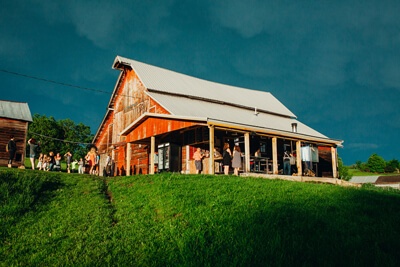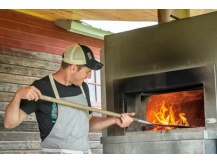
Luna Valley Pizza Farm celebrates two year anniversary
As I turn off Middle Sattre Road onto the path leading to Luna Valley Pizza Farm, I'm greeted with a cacophony of bleats, snorts, and squeals—lambs, lots of them, racing along a stream and happy about the mild mid-summer weather. Tom and Maren Beard bought this farm five years ago. It's a 133-acre lot, fit snuggly in the crook of a valley. The farm is certified organic, with 80 tillable acres (corn, oats, and wheat) and the rest forest and pasture. Tom and Maren raise 15 beef cows, 140 ewes, and 18 pigs.
Two years ago they started hosting Friday pizza nights, with ingredients sourced locally and from their organic farm. The pizza nights were a hit. Customers were eager to escape for the country and hungry for artisan pizzas sustainably-sourced. Hungry, too, for a dining experience that wasn't rushed, where customers savored both food and the pastoral landscape of a working farm.
In addition to the pizza farm, Tom and Maren last season began offering "glamping," short for "glamorous camping." Two large platform tents are available for rental, each tent including a private patio, king bed, Brooklinen sheets, LED lamps, and thick tent walls. Glamping is gaining in popularity; satisfying a growing demand for alternative overnight accommodations.
On July 4th weekend, Tom, Maren, and their team in the kitchen fired-up a record 200 hand-stretched pizzas. Maren invites me to watch her prepare dough the Wednesday morning before Nordic Fest. They're expecting a big night Friday. I enjoy baking, so I'm eager to see the commercial kitchen and geek out with Maren about dough. I'm also curious to learn about their farm, the pizza nights, and Tom and Maren's philosophy of sustainable entrepreneurship.
When I enter the kitchen Maren is already dividing dough into blobs, kneading these blobs, and placing them neatly in rows in long, squat containers. These containers are then placed in a walk-in cooler, where the dough cold-ferments until Friday mid-afternoon. Cold-fermenting yeasted doughs adds flavor (a sweet tanginess) and typically makes the dough more pliable and easier to hand-stretch.
Maren is outgoing and industrious, and she transfers these qualities to her kitchen: she's eager to answer my questions thoughtfully while simultaneously kneading dough.
The pizza menu is seasonal, changing as the local growing season progresses and different produce is available. Nearly all the meat toppings come from livestock raised on Luna Valley Farm, including kielbasa, Italian sausage, bacon, lamb, ham, and ground pork. Most of the produce is sourced from local organic farms. Some organic produce, like eggplant, sweet peppers, onions, leaks, garlic, cabbage, and broccoli, come from Maren and Tom's garden.
Around noon each Friday, either Maren or Tom load a large wheelbarrow with dry wood from the surrounding forest and roll it up to the 4,200 lbs. Valoriani wood-fire oven. It's an enormous and expensive device, hand-assembled in Italy, shipped to the U.S., and fork-lifted into place behind the bar, where it will presumably stay for some time. They begin loading in dry wood and start the three-hour process of preheating the oven to 950 degrees Fahrenheit. At such high heat, pizzas only take about 90 seconds to bake.
Pizza prep begins mid-afternoon Friday in their roomy and brisk commercial kitchen. Pizzas are prepped by a team of energetic young people, typically four of them: two stretching dough, two topping pies. The dough is stretched by hand in stages until it reaches 16 inches diameter, then it's scooped up, placed in the topping station, and in less than two minutes a pizza is prepped and ready for Tom to sling into the gapping, fiery mouth of the Valoriani oven. Tom's a stoical guy, and this, coupled with his broad frame and long arms, make him suited for tossing pizzas into a 950 degree contained inferno. He obviously knows what he's doing: besides some singed arm hair, he hasn't been burned by the oven.
On Friday mid-afternoon, with Nordic Fest in full swing 10 miles away, Luna Valley Pizza Farm is gearing up for a big night. Large groups have already called, giving advance notice of their arrival. When I arrive shortly before they open, half a dozen cars are already parked in the large grass parking lot.
Before I eat, I walk around their farm, peeking into the large breezy barn, walking past sheds and machinery, fenced-in livestock, hay bales, a garden, pasture—different things, biological and otherwise, that contribute to the operation of Luna Valley Pizza Farm.
I've never had a garden; I don't know what it's like to prepare a salad with greens I've grown. I imagine it's similar to how I feel when I bake bread: self-sufficient, elemental and creative, as if I'm part of the long history of people creating things. I sometimes wax poetic when I'm hungry. But it's not just hunger that's making me swoon over the wind-swept oat field. And it isn't just hunger that's making me look at those pigs differently—cute, yes, but also a delicious and essential component of the Pig and Fig—the pizza I soon order and hungrily devour.
Site designed and maintained by Iroc Web Design Services©.
Your Small Business Web Design Solutions.™




